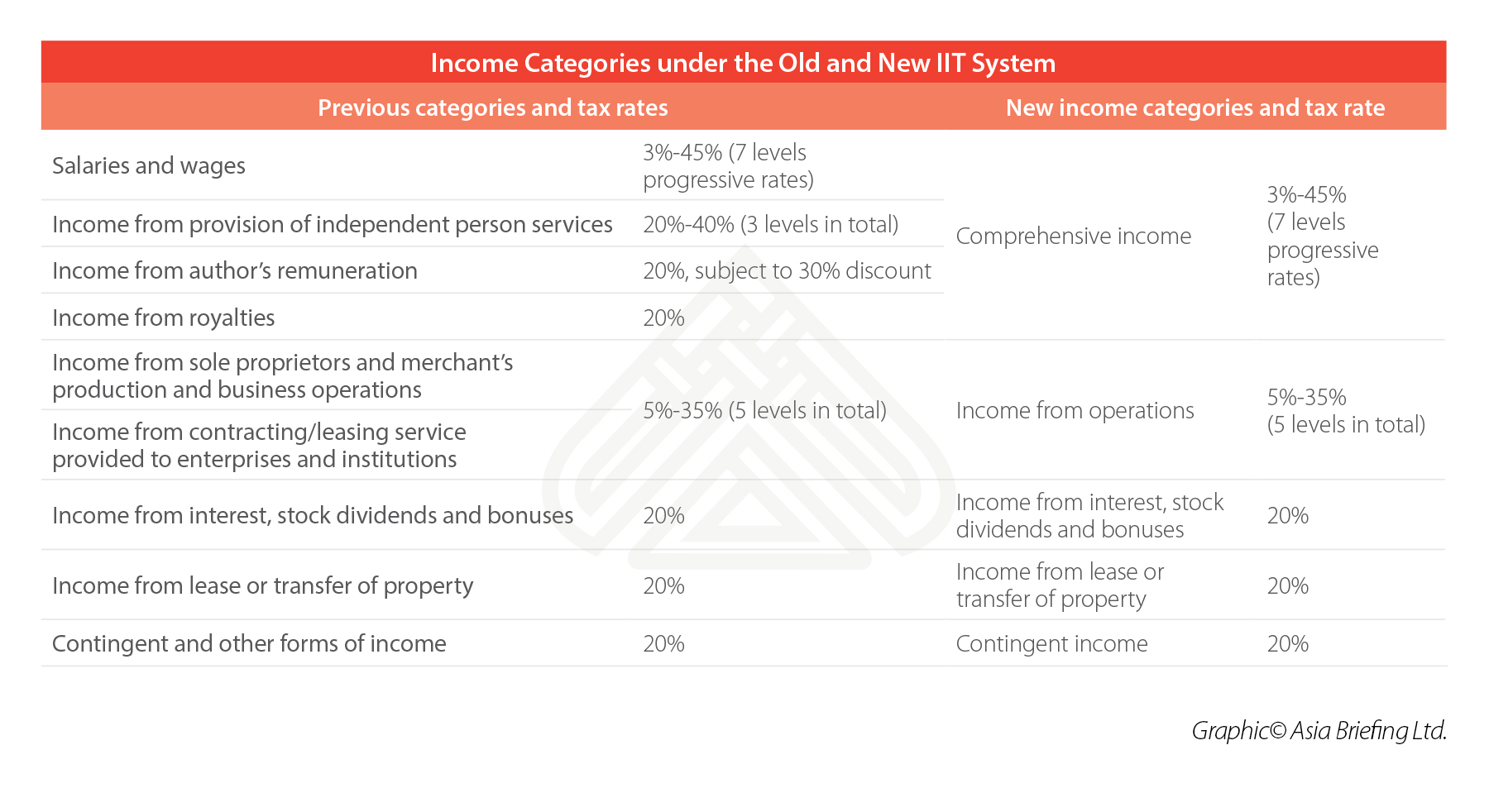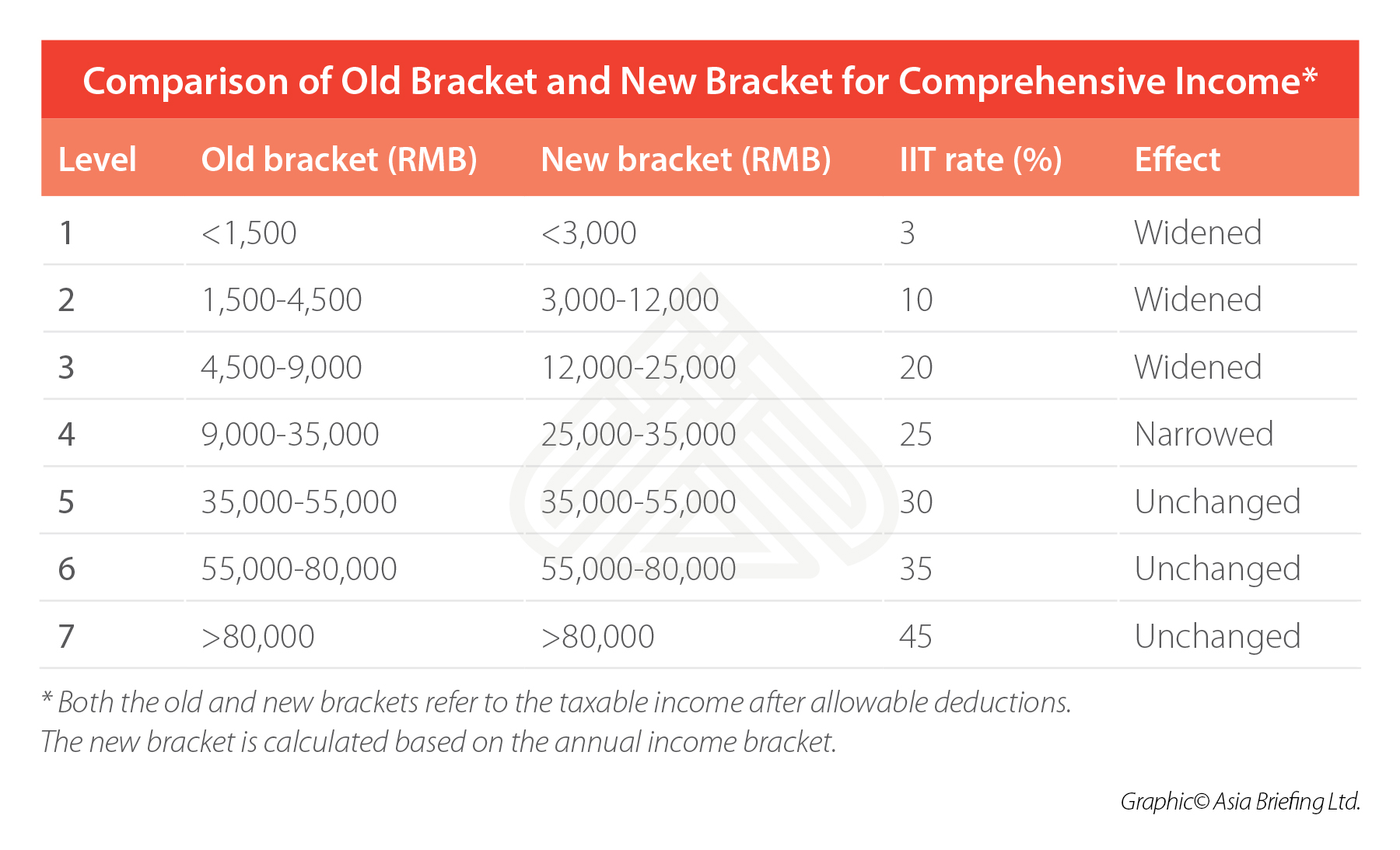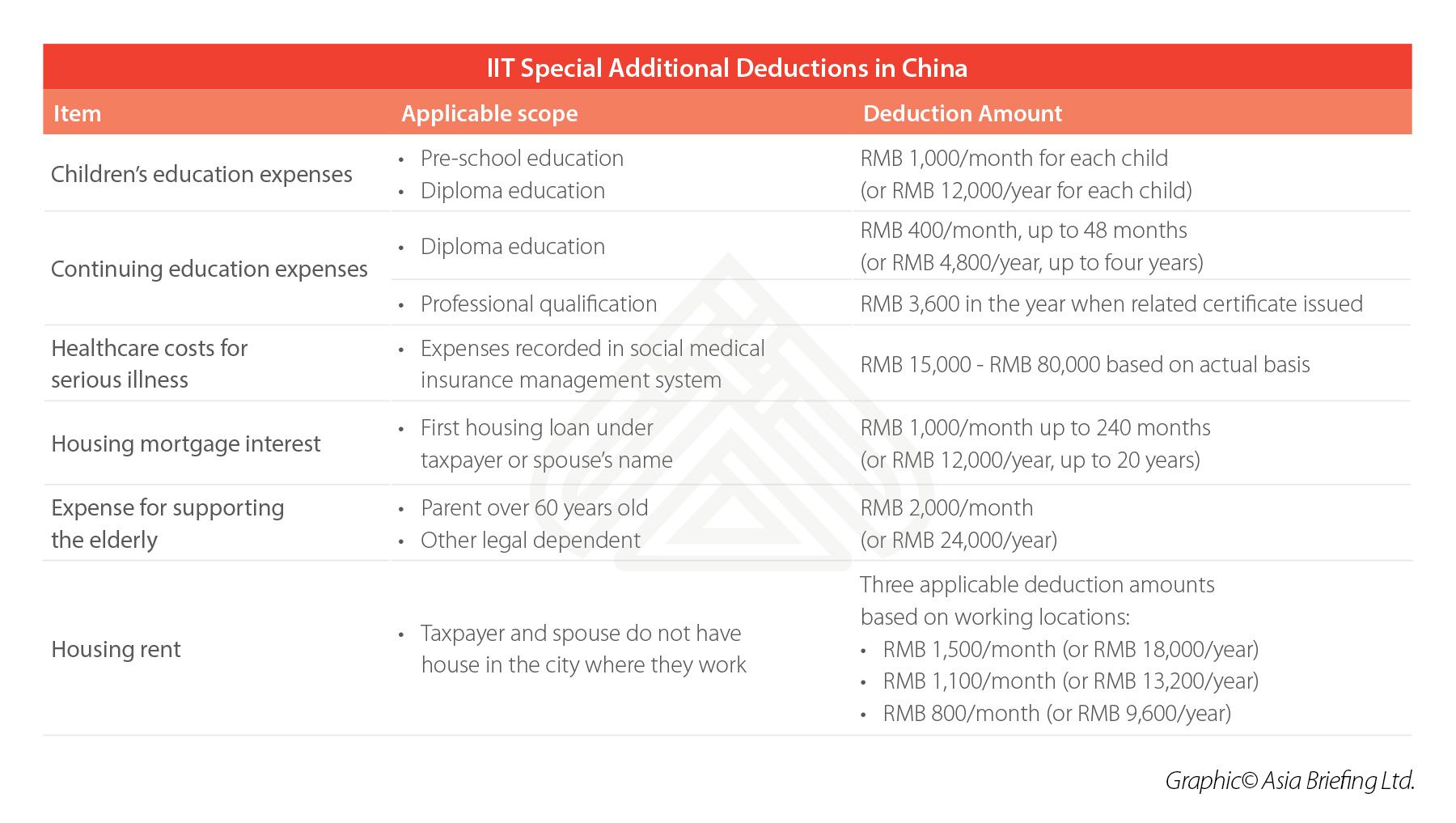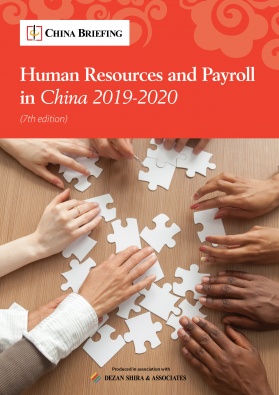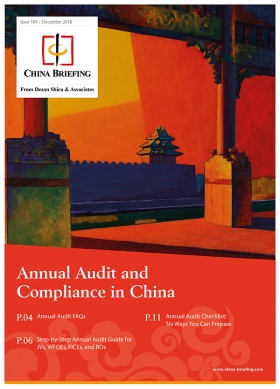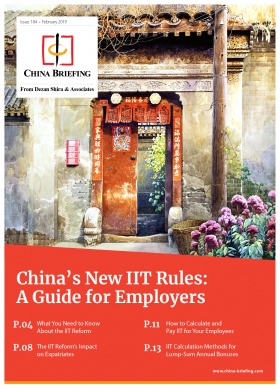What You Need to Know about China’s New IIT Regime
China’s IIT reform introduced a host of changes to the system of individual taxation in the country last year.
China Briefing explains the revisions to the tax brackets, expansion of deductibles, and new residency rules for foreign workers.
China began the latest reforms to its individual income tax (IIT) system at the beginning of 2018 when the government unveiled the Draft Amendments.
The IIT Law was passed in June 2018 and the new IIT system came into force on January 1, 2019 – the whole process taking effectively less than a year.
The changes affect the take-home pay of every employee and payroll processing for every employer in China. While many of the reforms were announced in phases across last year, the new IIT rules are now clear.
Tax residency
The new IIT Law adopts a 183-day test to determine the China tax residency, under which a foreign individual who has no domicile, but resides in China for 183 days or more cumulatively per tax year (January 1-December 31), is deemed a ‘tax resident’, and subject to Chinese IIT on worldwide income.
In comparison with the previous one-year test, the new rule is more consistent with international practices. However, foreign employees are concerned that the new test has shorter time requirements for triggering tax residency in China.
Tax authorities have sought to retain, amend, and upgrade some previous preferential exemptions for expatriates under the IIT Implementation Regulation. These include:
- Six-year rule: Foreign individuals will be exempt from paying IIT on income sourced outside China and paid by overseas employers, upon filing with the tax bureau in charge, until they reside in China for six consecutive years. The six-year rule is an upgrade of the previous five-year rule, under which foreign individuals will be taxed on their global income by residing in China for five consecutive years.
According to the official statement, the six-year rule will be effective starting from January 1, 2019. That is to say, the number of years before 2019 will not be included into the six-year count, and individuals who have no domicile in China won’t be subject to Chinese IIT on their worldwide income before the year 2024. - Clock reset: Where foreign individuals leave China for more than 30 days continuously in any year in which they reside in China for 183 days or more cumulatively, the computation of the six years will restart.
The new clock reset rule is less preferential because it removes foreign individuals’ ability to reset their years by leaving China for over 90 days cumulatively. For ease of reference, the below table breaks down the new tax residency rule.
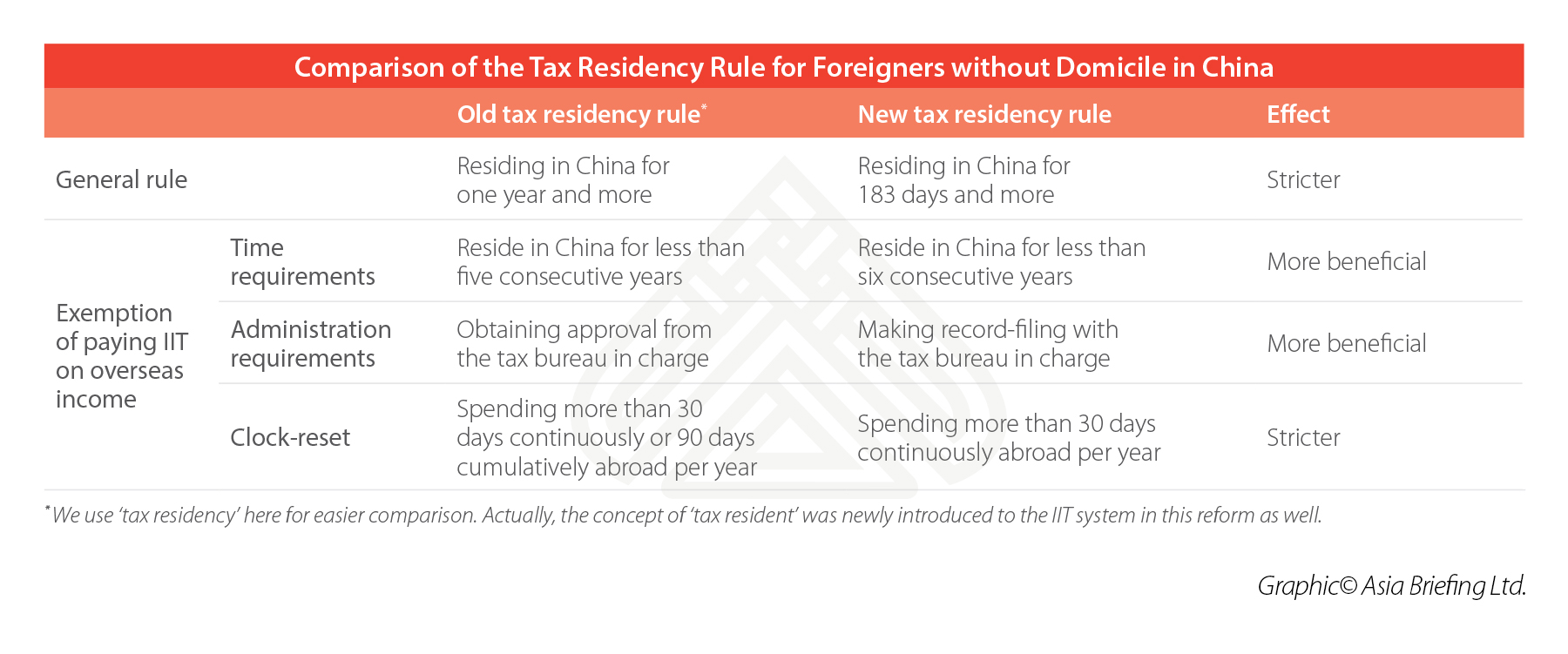 Taxable income
Taxable income
The new IIT Law consolidates some categories of income under the old IIT system into new categories.
Most significantly, for tax residents, it combined three types of income that were traditionally taxed at a flat rate of 20 percent, namely income derived from labor services, income from author’s remuneration, and income from royalties, with wages and salaries earned through employment, and formed a new category called ‘comprehensive income’.
This new category of income is subject to progressive rates from three to 45 percent.
This is likely to increase the tax levied on income belonging to this income category, as the progressive rates will now be applied to the aggregate of the four types of ‘comprehensive income’, rather than just ‘wages and salaries’.
Tax rates higher than 20 percent will be easier to trigger.
But because most taxpayer’s income are wages and salaries from single employer, the effect of this change is limited for most taxpayers. For ease of reference, the table below breaks down the income category changes.
Tax brackets
The new IIT Law changes the tax brackets applying to the ‘comprehensive income’ and ‘income from operations’.
For the purpose of this article, we introduce the changes to the tax brackets of the ‘comprehensive income’ as shown in the below table.
The reform has expanded the lower tax brackets, narrowed the middle tax bracket, and maintained the higher tax brackets. This means more people can access lower IIT rates and enjoy tax cuts.
For example, under the old system, an individual with a taxable income (after deductions) of RMB 10,000 (US$1,468) per month will be subject to 25 percent of tax resulting in RMB 1,495 (US$219) levy every month.
If their taxable income remains unchanged, they will pay RMB 17,940 (US$2,634) in IIT for the year.
Under the new system, an individual with the same taxable income will be subject to a 10 percent tax rate and will only need to pay RMB 9,480 (US$1,392) [RMB 790 x 12 months] levy every year, saving around 50 percent of the payable tax amount.
Standard deduction
The new IIT Law unified the standard deduction of resident individuals and non-resident individuals to RMB 5,000 (US$734) per month. This leveled deductions for residents and nonresident taxpayers, and increased the amount taxpayers can deduct.
Previously, the standard deduction for resident individuals was RMB 3,500 (US$514) per month, while this number was RMB 4,800 (US$705) for non-resident individuals.
Special additional deductions
The new IIT system introduced ‘special additional deductions for specific expenditures’.
This includes:
- Children’s education expenses;
- Continuing education expenses;
- Healthcare costs for serious illness;
- Housing mortgage interest;
- Expense for supporting the elderly; and,
- Housing rent.
The introduction of special additional deductions makes the Chinese IIT system more consistent with international practices. It applies to both resident and non-resident taxpayers.
According to the IIT Special Deduction Procedure (Trial Implementation), most special additional deductions should be deducted on a standard basis.
For example, the deduction standard for children’s education expense is RMB 1,000 a child per month, regardless of the actual expense in the month.
For reference, the applicable scope, deduction standard, and deduction method of each specific expenditures are summarized below.
Annual tax settlement
The new IIT Law introduces the tax settlement mechanism to the IIT system, under which resident taxpayers are required to make a settlement during the period between March 1 and June 30 the following year.
This mechanism applies specifically to the following scenarios:
- Taxpayers deriving comprehensive income from two or more sources, and the balance after deducting special deductions (that is, mandatory social insurances and housing fund) from the amount of annual comprehensive income exceeds RMB 60,000 (US$8,962);
- Taxpayers deriving one or more items of comprehensive income from labor services, author’s remuneration or royalties, and the balance after deducting special deductions from the amount of annual comprehensive income exceeds RMB 60,000 (US$8,962);
- Taxpayers who paid an amount in advance within a tax year that is less than the tax payable amount; and
- Taxpayer applied for a tax refund.
Tax declarations
The new IIT Law changed the circumstances in which taxpayers are required to make a tax declaration. The reform removed some old circumstances: a taxpayer, for example, is no longer required to declare annual income over RMB 120,000 (US$17,925).
But the reform also added some new circumstances: taxpayers now need to make a declaration upon emigration. For ease of reference, we have detailed the circumstances under which taxpayers need to make a tax declaration below.
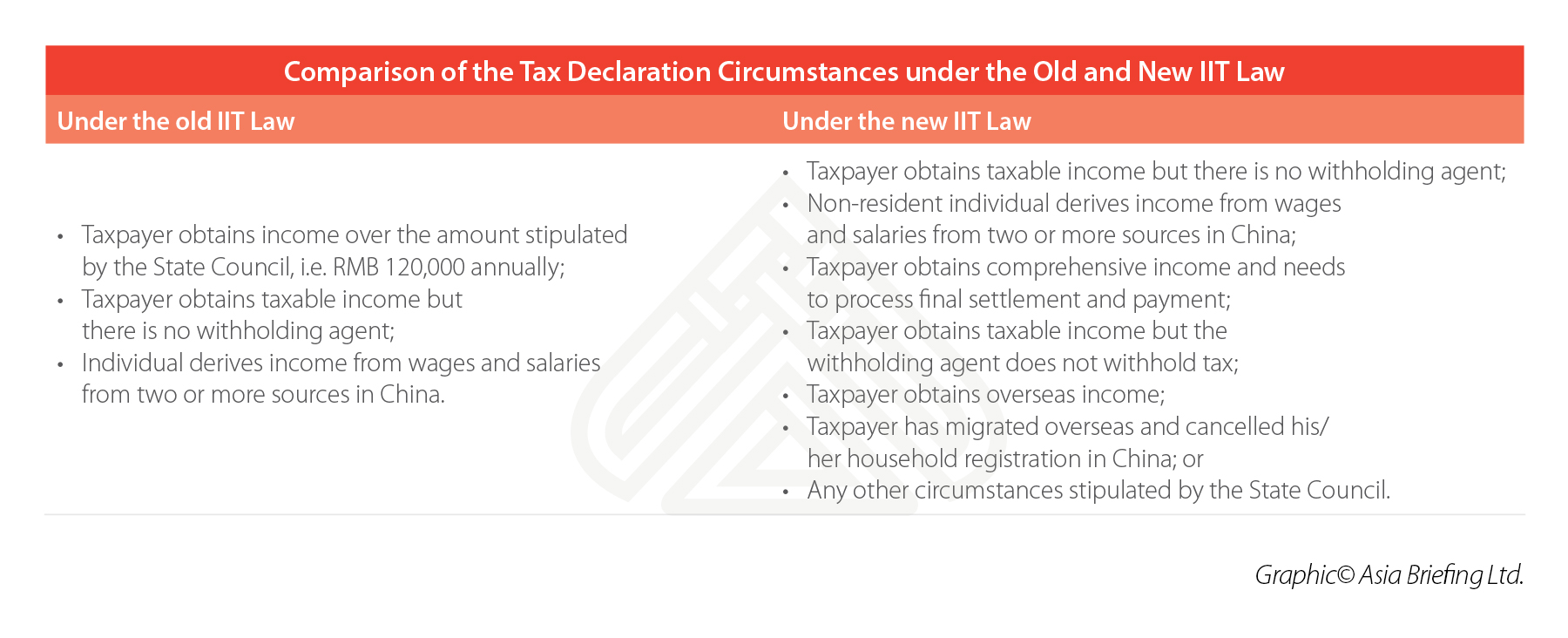
Key takeaways
The IIT reform marks a major change to China’s taxation policies. With the introduction of the new IIT Law, low- and mid-income earners enjoy greater tax relief, while individual taxpayers of all stripes benefit from a broader range or deductibles.
At the same time, the new IIT Law has brought significant changes to the IIT collection and administration mechanism. The adoption of an annual levy system and the 183-day residence rule marks a gradual shift towards more international tax practices.
Given the scope of the changes, and the potential for closer regulatory scrutiny from tax authorities, employers need to assess their payroll policies, implement changes to stay compliant, and communicate with their employees about any changes for them.
About Us
China Briefing is produced by Dezan Shira & Associates. The firm assists foreign investors throughout Asia from offices across the world, including in Dalian, Beijing, Shanghai, Guangzhou, Shenzhen, and Hong Kong. Readers may write to china@dezshira.com for more support on doing business in China.
- Previous Article Are Foreign High-Tech Companies Really Leaving China?
- Next Article Greater Bay Area Releases Detailed Plan on IIT Incentives for Overseas Talents

